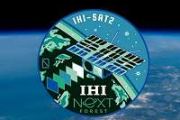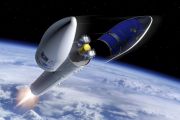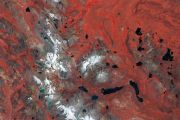
Copernical Team
Tianzhou-3 docks with Tianhe's front docking port
 China's cargo spacecraft Tianzhou-3 separated from the country's space station core module Tianhe and redocked with the module on Wednesday.
Tianzhou-3 detached from the rear docking port of Tianhe at 5:02 a.m. (Beijing Time), moved to the module's front port and completed a computer-orchestrated rendezvous and docking at 9:06 a.m., according to the China Manned Space Agency.
It also
China's cargo spacecraft Tianzhou-3 separated from the country's space station core module Tianhe and redocked with the module on Wednesday.
Tianzhou-3 detached from the rear docking port of Tianhe at 5:02 a.m. (Beijing Time), moved to the module's front port and completed a computer-orchestrated rendezvous and docking at 9:06 a.m., according to the China Manned Space Agency.
It also SpaceX launches another 53 Starlink satellites into space
 A SpaceX Falcon 9 rocket launched from Cape Canaveral Space Force Station in Florida on Thursday, carrying another 53 Starlink Internet satellites into space.
The rocket lifted off at 1:51 p.m. from Launch Complex 40 after a 3-hour delay due to strong winds. It was the 43rd launch related to the Starlink project.
SpaceX said the first-stage booster of the Falcon 9 rocket landed o
A SpaceX Falcon 9 rocket launched from Cape Canaveral Space Force Station in Florida on Thursday, carrying another 53 Starlink Internet satellites into space.
The rocket lifted off at 1:51 p.m. from Launch Complex 40 after a 3-hour delay due to strong winds. It was the 43rd launch related to the Starlink project.
SpaceX said the first-stage booster of the Falcon 9 rocket landed o Western's all-sky cameras capture bright fireball event
 A bright fireball was observed by a network of all-sky cameras across southern Ontario at 11:37pm on Sunday, April 17, 2022. Analysis of the video data suggests that fragments of the meteor are likely to have made it to the ground near the eastern shore of Lake Simcoe, just north of the town of Argyle.
Western University's physics and astronomy department runs an all-sky camera network tha
A bright fireball was observed by a network of all-sky cameras across southern Ontario at 11:37pm on Sunday, April 17, 2022. Analysis of the video data suggests that fragments of the meteor are likely to have made it to the ground near the eastern shore of Lake Simcoe, just north of the town of Argyle.
Western University's physics and astronomy department runs an all-sky camera network tha Where no satnav has gone before
 The test version of a unique satellite navigation receiver has been delivered for integration testing on the Lunar Pathfinder spacecraft. The NaviMoon satnav receiver is designed to perform the farthest ever positioning fix from Earth, employing signals that will be millions of times fainter than those used by our smartphones or cars.
"This engineering model of our NaviMoon receiver is the
The test version of a unique satellite navigation receiver has been delivered for integration testing on the Lunar Pathfinder spacecraft. The NaviMoon satnav receiver is designed to perform the farthest ever positioning fix from Earth, employing signals that will be millions of times fainter than those used by our smartphones or cars.
"This engineering model of our NaviMoon receiver is the Kymeta to offer mission-critical LEO connectivity through OneWeb Technologies
 Kymeta and OneWeb Technologies announced an agreement to distribute reliable, secure, and cost-effective broadband connectivity services to the U.S. government.
The new managed satellite service offering enables Kymeta to provide government customers with hardware solutions that are packaged with secure and resilient network access from OneWeb Technologies, a wholly owned subsidiary of low
Kymeta and OneWeb Technologies announced an agreement to distribute reliable, secure, and cost-effective broadband connectivity services to the U.S. government.
The new managed satellite service offering enables Kymeta to provide government customers with hardware solutions that are packaged with secure and resilient network access from OneWeb Technologies, a wholly owned subsidiary of low NASA and industry to collaborate on space communications initiative
CGI supports creation of the European satellite constellation UN:IO
 The European Commission has contracted IT service provider CGI as part of a consortium to contribute its expertise in the fields of space and cybersecurity for helping to build the independent European satellite constellation dubbed UN:IO. It is expected to begin operating commercial and institutional communication channels by 2025. ?
The European Union's top priority is a secure, extremel
The European Commission has contracted IT service provider CGI as part of a consortium to contribute its expertise in the fields of space and cybersecurity for helping to build the independent European satellite constellation dubbed UN:IO. It is expected to begin operating commercial and institutional communication channels by 2025. ?
The European Union's top priority is a secure, extremel Curiosity goes oops Sols 3451-3452
 Not that it matters, but exactly 100 sols ago, on January 7th, we were planning sols 3351 and 3352, and it was this blogger's turn to report on what was happening. Apparently, we were marvelling at the landscape - and dealing with a rock under the foot, well, the wheel.
Tosol, we were again dealing with a rock right under the rover, but this time, we were excited about it as the rover was
Not that it matters, but exactly 100 sols ago, on January 7th, we were planning sols 3351 and 3352, and it was this blogger's turn to report on what was happening. Apparently, we were marvelling at the landscape - and dealing with a rock under the foot, well, the wheel.
Tosol, we were again dealing with a rock right under the rover, but this time, we were excited about it as the rover was Perseverance captures video of solar eclipse on Mars
 NASA's Perseverance Mars rover has captured dramatic footage of Phobos, Mars' potato-shaped moon, crossing the face of the Sun. These observations can help scientists better understand the moon's orbit and how its gravity pulls on the Martian surface, ultimately shaping the Red Planet's crust and mantle.
Captured with Perseverance's next-generation Mastcam-Z camera on April 2, the 397th Ma
NASA's Perseverance Mars rover has captured dramatic footage of Phobos, Mars' potato-shaped moon, crossing the face of the Sun. These observations can help scientists better understand the moon's orbit and how its gravity pulls on the Martian surface, ultimately shaping the Red Planet's crust and mantle.
Captured with Perseverance's next-generation Mastcam-Z camera on April 2, the 397th Ma Axiom crew set for return to Earth on Sunday, Crew-4 to launch days later
 The first private astronaut crew aboard the International Space Station is set to return to Earth on Sunday after weather delays and NASA's Crew-4 mission will look to launch on Tuesday.
"The decision [to delay landing] was made based on the best weather for splashdown of the first private astronaut mission to visit the International Space Station and the return trajectory required to b
The first private astronaut crew aboard the International Space Station is set to return to Earth on Sunday after weather delays and NASA's Crew-4 mission will look to launch on Tuesday.
"The decision [to delay landing] was made based on the best weather for splashdown of the first private astronaut mission to visit the International Space Station and the return trajectory required to b 





























